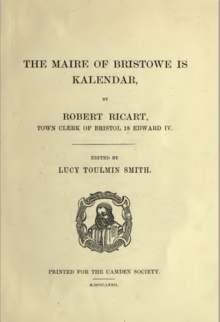
Totnes is a market town and civil parish at the head of the estuary of the River Dart in Devon, England, within the South Devon Area of Outstanding Natural Beauty. It is about 5 miles (8.0 km) west of Paignton, about 7 miles (11 km) west-southwest of Torquay and about 20 miles (32 km) east-northeast of Plymouth. It is the administrative centre of the South Hams District Council.
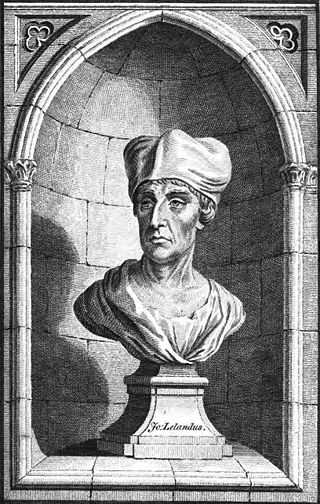
John Leland or Leyland was an English poet and antiquary.

Corineus, in medieval British legend, was a prodigious warrior, a fighter of giants, and the eponymous founder of Cornwall.
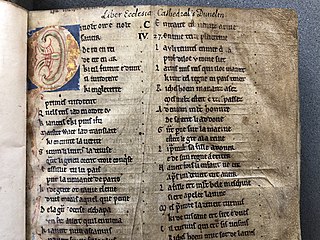
The Brut or Roman de Brut by the poet Wace is a loose and expanded translation in almost 15,000 lines of Norman-French verse of Geoffrey of Monmouth's Latin History of the Kings of Britain. It was formerly known as the Brut d'Engleterre or Roman des Rois d'Angleterre, though Wace's own name for it was the Geste des Bretons, or Deeds of the Britons. Its genre is equivocal, being more than a chronicle but not quite a fully-fledged romance.

St Mark's Church is an ancient church on the north-east side of College Green, Bristol, England, built c. 1230. Better known to mediaeval and Tudor historians as the Gaunt's Chapel, it has also been known within Bristol since 1722 as the Lord Mayor's Chapel. It is one of only two churches in England privately owned and used for worship by a city corporation. The other is St Lawrence Jewry, London. It stands opposite St Augustine's Abbey, founded by a member of the Berkeley family of nearby Berkeley Castle, from which it was originally separated by the Abbey's burial ground, now called College Green. It was built as the chapel to the adjacent Gaunt's Hospital, now demolished, founded in 1220. Except for the west front, the church has been enclosed by later adjacent buildings, although the tower is still visible. The church contains some fine late gothic features and a collection of continental stained glass. It is designated by Historic England as a grade I listed building.

Bewell's Cross is a lost monument which marked the boundary of Bristol. The name 'Bewel' goes back at least as far as 1188, when it is referred to in a charter of King John as one of four points marking the limits of Bristol. The placenames specialist, Richard Coates, suggests that 'Bewell' is probably derived from the Old English for 'bee well' - i.e. a spring or well associated with bees. However, he notes that is just possible that the name represents a pruning of 'Beowolf's Well', given that a Bristolian called Elias or Elys recorded in about 1270 with the surname Beowolf.
Events from the 1470s in England.

Corn Street, together with Broad Street, Wine Street and High Street, is one of the four cross streets which met at the Bristol High Cross, the heart of Bristol, England when it was a walled medieval town. From this crossroads Corn Street and its later extension Clare Street runs downhill approximately 325m south-westwards to The Centre.

Brut y Brenhinedd is a collection of variant Middle Welsh versions of Geoffrey of Monmouth's Latin Historia Regum Britanniae. About 60 versions survive, with the earliest dating to the mid-13th century. Adaptations of Geoffrey's Historia were extremely popular throughout Western Europe during the Middle Ages, but the Brut proved especially influential in medieval Wales, where it was largely regarded as an accurate account of the early history of the Celtic Britons.

Lucy Toulmin Smith (1838–1911) was an Anglo-American antiquarian and librarian, known for her first publication of the York Mystery Plays and other early works.
Bristol City Council, formerly known as The Bristol Corporation, is the local government authority governing the city of Bristol, England. Following the Norman conquest of England in 1066, successive royal charters granted increasing rights of local governance to Bristol. County status was attained in 1373 and city status in the early sixteenth century. Bristol Corporation was established in the nineteenth century and the office of Lord Mayor was created in 1888. Following a brief period as part of the county of Avon in the late twentieth century, Bristol regained its status as a city and county in 1996.

Goffar known as Goffar the Pict, was a pseudo-historical king of Aquitaine around the year 1000 BCE in Geoffrey of Monmouth's Historia Regum Britanniae. In the story, he was defeated by Brutus of Troy and Corineus on their way to Britain. Later histories of Britain and France included Goffar from Historia Regum Britanniae, and sometimes expanded the story with some additional details.

Gogmagog was a legendary giant in Welsh and later English mythology. According to Geoffrey of Monmouth's Historia Regum Britanniae, he was a giant inhabitant of Albion, thrown off a cliff during a wrestling match with Corineus. Gogmagog was the last of the Giants found by Brutus and his men inhabiting the land of Albion.

Buckingham was an ancient borough in England centred on the town of Buckingham in the county of Buckinghamshire, and was first recorded in the 10th century. It was incorporated as a borough in 1553/4 and reformed under the Municipal Corporations Act 1835. In 1974, it was abolished as part of local government re-organisation under the Local Government Act 1972, and absorbed by Aylesbury Vale District Council.
The following is a timeline of the history of the city of Bristol, England.

Wine Street, together with High Street, Broad Street and Corn Street, is one of the four cross streets which met at the Bristol High Cross, the heart of Bristol, England when it was a walled mediaeval town. From this crossroads Wine Street runs along a level ridge approximately 175m north-eastwards to the top of Union Street.
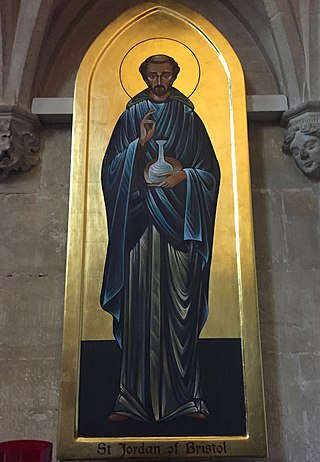
Jordan of Bristol was a saint venerated in Bristol, England, before the Reformation, about whom little is known with certainty.
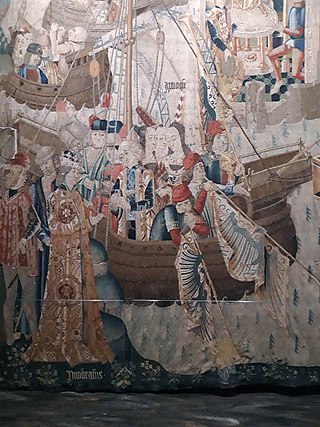
Pandrasus is the fictional king of Greece and father of Innogen in Geoffrey of Monmouth's pseudo-history Historia Regum Britanniae.
The Bristol perambulation was a civic ritual, usually performed annually, in Bristol, England, from the sixteenth to the nineteenth centuries. Also called 'beating the bounds' it usually involved a party of civic officers walking or riding around the 8 miles (12.9 km) land boundary of the city and county of Bristol. On the way they inspected the 'shirestones' to ensure all were visible and in good order.
